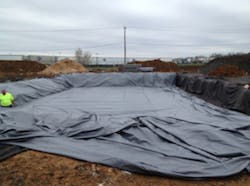Located in Mechanicsburg, Pa., the 2.83-mile stretch of U.S. Route 11 (Carlisle Pike) from SR 581 (Harrisburg Expressway) to SR 114 has become a commercial and residential hub within a rural landscape. Both sides of the four-lane highway are lined with commercial centers, car dealerships and residential developments, making it a prime location for gas stations.
Sheetz Inc., a regional gas station chain, opted to take advantage of the booming development and lack of competition in the area. However, all available commercial sites along the highway were already developed, forcing Sheetz to purchase two small properties that were available for repurposing. Access streets surrounded the properties, making their location ideal for a gas station. Plans called for the demolition of all existing infrastructure and facilities, as well as a new site layout.
A redeveloping issue
The problem Sheetz faced was the same problem that faces any company looking to redevelop a property: Repurposing previously developed land creates a series of logistical issues. In this case, the challenge was fitting a full-service drive-through convenience store, an automated car wash and gas pumps into a site previously used by a small restaurant and a small office.
Sheetz first pursued eliminating the second series of gas pumps utilized in typical gas station layouts in favor of a single canopy. The second step involved relocating the storm water mitigation facilities, necessary for the redevelopment of the site, underground.
Impermeable logic
To meet the regulatory requirements for volume and rate, the designers utilized a single-stacked system that fit the tight dimensional constraints of the necessary infrastructure for a drive-through convenience store, car wash and gas station on one site. The basin provided slightly more than 10,476 ft3 of storm water storage without interrupting the available developable land. This was key to project development as 68% of the workable surface area was to be purposed as impermeable, requiring the designers to handle storm water mitigation creatively in the form of underground storage. Additionally, the topography of the Mechanicsburg region required the incorporation of an impermeable liner around the basin to prevent sinkholes, which are common to the region.
Completed in the summer of 2013, the gas station provides service to a previously underserved community. Successfully installed, the Brentwood StormTank system has permitted the necessary mitigation to meet regulatory needs while expanding usable land and providing the necessary cleanability. The innovative design of this project met the needs of the designer, owner, community and regulatory agencies.
